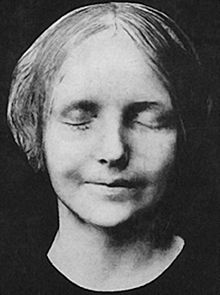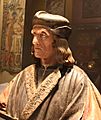Death mask facts for kids
A death mask is a special copy of a person's face, usually made right after they have died. It can be made from materials like wax or plaster. People have used death masks for different reasons throughout history. Sometimes, they were kept as a way to remember someone important. Other times, artists used them to help create portraits or sculptures of the person.
When a death mask is made, the weight of the plaster can slightly change the shape of the face. This can sometimes help experts tell if a painting was made using a death mask.
In some ancient cultures, a death mask was a clay or other item placed on the face of the dead person before burial. The most famous examples are from ancient Egypt. Egyptians used masks as part of their mummification process. A well-known example is Tutankhamun’s burial mask.
In the 17th century in parts of Europe, death masks were sometimes used for special ceremonies. They were placed on a model of the person, called an effigy, during important funerals. Later, in the 18th and 19th centuries, these masks were also used to record the faces of people whose identity was unknown. Today, we use photographs for this purpose.
Contents
History of Death Masks
Early Sculpted Masks
Making masks of people who have died is a very old tradition in many countries. In ancient Egypt, a key part of the funeral ceremony was preparing the body through mummification. After special prayers, the body was placed in a sarcophagus, which was a decorated coffin. A special sculpted mask was placed on the dead person's face. Egyptians believed this mask helped protect the mummy's spirit and guided the soul safely to the afterlife.
The most famous Egyptian mask is that of Tutankhamun. It is made of gold and jewels and shows the king's features in a very artistic way. However, these masks were not made by taking a direct mold of the face. The mummification process itself helped preserve the person's features.
In 1876, the archaeologist Heinrich Schliemann found six graves in Mycenae, an ancient city. He thought these might be the graves of kings and famous Greek heroes like Agamemnon. To his surprise, the skulls in these graves were covered with gold masks. Today, many experts believe it's unlikely these masks belonged to the specific heroes mentioned in the stories of Homer.
The very realistic look of Roman portrait sculptures might be connected to an earlier Roman custom. Romans used wax to keep the features of dead family members. These wax masks were then sometimes used to create stone sculptures.
Casts of Faces

Around the late Middle Ages, people started making true death masks from wax or plaster. These masks were different because they were not buried with the dead. Instead, they were used in funeral ceremonies and then kept in places like libraries, museums, or universities.
Death masks were made not only for kings and queens, like Henry VIII or members of the House of Sforza, but also for important thinkers and artists. These included poets like Dante Alighieri, architects like Filippo Brunelleschi, and writers like Voltaire. Just like in ancient Rome, these death masks were often used to help create marble sculptures, busts, or engravings of the person.
The death mask of Oliver Cromwell is kept at Warwick Castle in England. Another famous mask is that of Napoleon Bonaparte. It was made on the island of Saint Helena and is now displayed at London’s British Museum.
In Russia, the tradition of making death masks goes back to the time of Peter the Great. His death mask was made by an artist named Carlo Bartolomeo Rastrelli. Other well-known Russian death masks include those of Alexander I, Nicholas I, and Alexander II.
One of the first real Ukrainian death masks was that of the poet Taras Shevchenko. It was made by Peter Clodt von Jürgensburg in St. Petersburg, Russia.
Science and Study
From the late 1700s, scientists began using death masks to study differences in human faces. They also started making "life masks" from living people. Anthropologists, who study human societies and cultures, used these masks to look at facial features of famous people and sometimes even criminals. Masks were also used to collect information about different human groups.
Helping Identify People
Before cameras were invented, death masks were sometimes made to help identify people whose bodies were found but whose names were unknown. This way, if relatives were looking for a missing person, they might recognize the face from the mask.
One famous mask, called L'Inconnue de la Seine, was made from the face of a young woman who drowned in the Seine River in Paris around the late 1880s. A worker at the Paris morgue was so impressed by her beauty that he made a plaster cast of her face. This mask became very popular in Parisian artistic circles. Later, the face of Resusci Anne, the first CPR training mannequin introduced in 1960, was actually based on L'Inconnue de la Seine.
Related pages
Images for kids
-
Golden funeral mask of Tutankhamun
-
A sculpture of Henry VII of England by Pietro Torrigiano, thought to be made using his death mask
See also
 In Spanish: Máscara mortuoria para niños
In Spanish: Máscara mortuoria para niños






